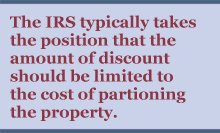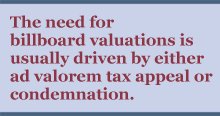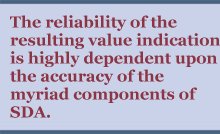

|
207 Abbey Lane Lansdale, Pennsylvania 19446 215-855-1800 |
5201 Ocean Avenue #2007 Wildwood, New Jersey 08260 215-990-6663 |
Specializing in Real Estate Appraisal and Property Tax Consulting
A Professional Courtesy of:
|

Specializing in Real Estate Appraisal and Property Tax Consulting |
| SPRING 2008 |
 |
|
In This Issue: |
|
Conservation Easements Conservation easements are land use restrictions voluntarily imposed by ownership. Such easements are negotiated between property owners and private charitable conservation organizations or government agencies. The latter is responsible for enforcing the terms of the restrictions specified in the easement agreement. Conservation easements may be donated, purchased, extracted or partially donated.Owners are motivated by the availability of tax benefits (both state and federal) and, in some cases, by an interest in protecting land from future development. Such protection may apply to farm and ranch land, timber land, open space, wetlands, floodplain, wildlife habitat, scenic views or historic land. In order to qualify for tax benefits, conservation easements must be permanent. Further, easements must be held by entities having the capacity to enforce the terms of the easement agreement. Land with conservation easements may be traded on the open market. Except for situations in which the purpose of the easement is for a public purpose, access by the public is not required. There are five types of tax benefits available to those donating easements, specifically
The accepted basis for valuing the conservation easement is on a "before and after" premise. Using this technique, the value of the easement is the difference between the values of the property with and without the easement. The value of the easement reflects the quantified loss associated with foregone uses to which the property could he put but for the existence of the easement. Between 1998 and 2003, the acreage protected by conservation easements in the United States increased from 1,385,000 acres to 5,067,929 acres. The number of easements increased from 7,392 in 1998 to 17,847 in 2003. There has been considerable controversy in the past few years over alleged abuses (i.e., the overstatement of easement valuations and resulting tax benefits). Cases have been reported in which the value of conservation easements has exceeded the value of the property as unencumbered. Indeed, the perception exists that a claim for such tax benefits is only as good as the supporting appraisal. Users should therefore seek appraisers with demonstrable expertise in such assignments. Furthermore, such appraisers should be able to demonstrate that they have completed specialized education in the valuation of conservation easements. Respected professional organizations such as the Appraisal Institute offer such specialized education. The federal law governing conservation tax benefits will soon expire. Congress is considering legislation to make such benefits permanent. The legislation, titled the Habitat and Land Conservation Act of 2007, was reported out of the Senate Finance Committee by unanimous vote on August 21, 2007. Passage by Congress is anticipated. The issues and complexities surrounding conservation easements are many. Knowledgeable professionals, including real estate appraisers, should be consulted in the decision-making process. |
Partial Interests in Real Estate The ownership (if real estate may he held in various forms. Individual ownership involving one person is termed ownership in severalty. When multiple persons are involved, tenancy is created. Ownership may be by joint tenancy, tenancy by the entirety or tenancy in common.Ownership may be by entities such as land trusts, partnerships (both general and limited), corporations and companies and syndications. The latter have been rarely used since the revision of the federal tax code in 1986.  The need tor the valuation of partial interests is usually caused by estate tax filing, gift or litigation among owners of the same property or entity. When the interest to be valued is a minority interest (less than 50%), the issue of an appropriate discount is of significance.
The need tor the valuation of partial interests is usually caused by estate tax filing, gift or litigation among owners of the same property or entity. When the interest to be valued is a minority interest (less than 50%), the issue of an appropriate discount is of significance.Such a discount is typically based upon (a) lack of control and/or (b) limitations on the marketability. The discount for lack of control recognizes the relative undesirability of not being able to make and implement important decisions about the asset. The discount for limited marketability is based upon the premise that there are unlikely to be buyers of a minority interest unless the price has been discounted.  While many courts recognize minority interest discounts as appropriate, the IRS typically takes the position that the amount of discount should be limited to the cost of partitioning (dividing) the property. Such costs include attorneys' fees and related costs, together with the time necessary to obtain and sell such a partitioned minority interest.
While many courts recognize minority interest discounts as appropriate, the IRS typically takes the position that the amount of discount should be limited to the cost of partitioning (dividing) the property. Such costs include attorneys' fees and related costs, together with the time necessary to obtain and sell such a partitioned minority interest.Some properties (and the interest therein) can be easily partitioned. For example, a large tract of land may be divided on a pro rata basis. However, many other types of properties cannot be physically partitioned. It is improbable that an office building could be divided physically. In valuing private minority interests that cannot be partitioned, the appraiser is likely to find highly similar market data to be scarce or nonexistent. Reliance must then be placed upon value "proxies." Such proxies might be sales of public partnership interests in the secondary market. Similarly, a comparison of pre-IPO and post-IPO share prices may be helpful in estimating such discounts. Regardless of the situation, preparers and users of minority interest valuations wherein discounts are applied should anticipate scrutiny by the courts and/or the IRS. The casual estimation of such discounts is not acceptable. The role of the appraiser is clearly important in supporting minority interest valuations. The appraiser should demonstrate both education and experience in such assignments. |
Valuation of Billboards In industry vernacular, billboards are termed "out-of-home media," in contrast with newspapers, magazines, television and the Internet ("in-home media"). Billboards are also called "off premises" advertising, as differentiated from signage located on the premises of businesses.Billboards vary significantly in terms of structural material and design, configuration and display. Indeed, the various types are too numerous to cite herein.  A significant determinant of billboard value is the existence and decree of spatial monopoly. This term describes a billboard owner's sole right to display advertising along a highway or street. Value is likely to be positively correlated with the distance (spacing) from other competing billboards. Distance between billboards is typically mandated by city, county or state ordinances. Federal law also applies to billboards along the federal highway system. Demand for billboards is a function of (a) the audience potential and (b) proximity to advertising customer locations.
A significant determinant of billboard value is the existence and decree of spatial monopoly. This term describes a billboard owner's sole right to display advertising along a highway or street. Value is likely to be positively correlated with the distance (spacing) from other competing billboards. Distance between billboards is typically mandated by city, county or state ordinances. Federal law also applies to billboards along the federal highway system. Demand for billboards is a function of (a) the audience potential and (b) proximity to advertising customer locations.In practical terms, sign lease rates are a function of exposure time (i.e., the length of time vehicle occupants have to see the message on the billboard). The optimal exposure time is considered to be eight seconds. The need for billboard valuations is usually driven by either ad valorem tax appeal or condemnation. Applicable law, both statutory and case law, varies considerably by state.  A key valuation issue is whether billboards are real or personal property. Since personal property is not generally subject to ad valorem taxation or to compensability if taken by eminent domain, the distinction is an important one. As stated, state laws on this issue vary significantly.
A key valuation issue is whether billboards are real or personal property. Since personal property is not generally subject to ad valorem taxation or to compensability if taken by eminent domain, the distinction is an important one. As stated, state laws on this issue vary significantly.Billboards are typically constructed on leased land. While such lease data are easily attainable, sales of billboard leaseholds are quite difficult to find. This makes the valuation of such leaseholds difficult. While sales of outdoor advertising companies are available for analysis, the allocation of total firm price to billboards owned by the firm is fraught with weaknesses. A billboard company generally owns various types of assets in addition to billboards, such as offices and shops; furniture, fixtures and equipment; and intangibles. The most appropriate techniques used to value such leaseholds are the potential gross income multiplier and the effective gross income multiplier. The former is derived by dividing sale price by annual potential gross ad revenue. The latter reflects effective gross ad revenue (i.e., less vacancy and ad agency commission). The valuation of billboard leaseholds is a challenging undertaking. Nonetheless, appraisers with experience in such assignments are up to the challenge. |
Subdivision Valuation There are essentially two techniques available for the valuation of land that has subdivision development as its highest and best (optimum) use. Development may be residential, commercial or industrial in character. The preferred technique is termed direct sales comparison, in which transactions of similar tracts are compared with that being valued. After adjustments, the compatibles should provide a relatively narrow range of value indications upon which a value opinion may be based. The similarity of the selected comparables is, of course, a prime determinant of the accuracy of the resulting value indications. The second technique is called subdivision development analysis (SDA). SDA is a form of discounted cash flow analysis in which the source of revenue is the sale of subdivided lots rather than lease payments. The Appraisal of Real Estate, 12th Edition, defines SDA as "a method of estimating land value when subdivision and development are the highest and best use of the parcel of land being appraised. Direct and indirect costs and entrepreneurial profit are deducted from an estimate of the anticipated gross sales price of the finished lots, and the resultant net sales proceeds are then discounted to present value at a market-derived rate over the development and absorption period to indicate the value of the raw land." It is of critical importance that the optimum (highest and best) use of the tract be for subdivision and development. Unless this premise is correct, the resulting value estimate will likely be both inaccurate and misleading.
The second technique is called subdivision development analysis (SDA). SDA is a form of discounted cash flow analysis in which the source of revenue is the sale of subdivided lots rather than lease payments. The Appraisal of Real Estate, 12th Edition, defines SDA as "a method of estimating land value when subdivision and development are the highest and best use of the parcel of land being appraised. Direct and indirect costs and entrepreneurial profit are deducted from an estimate of the anticipated gross sales price of the finished lots, and the resultant net sales proceeds are then discounted to present value at a market-derived rate over the development and absorption period to indicate the value of the raw land." It is of critical importance that the optimum (highest and best) use of the tract be for subdivision and development. Unless this premise is correct, the resulting value estimate will likely be both inaccurate and misleading.In SDA, the value of the undeveloped tract is a residual (i.e., that which remains after all revenue and costs are accounted for). There are numerous elements to be considered and estimated in the SDA, including
 Clearly, the reliability of the resulting value indication is highly dependent upon the accuracy of the myriad components of SDA. One of the difficulties appraisers face in its application is the reliability of data provided by others. Since appraisers do not have the expertise to estimate many of these elements, they have little choice but to obtain such information from the sponsor of the proposed development. Nonetheless, appraisers must attempt to verify the reasonableness of the data, to the extent possible.
Clearly, the reliability of the resulting value indication is highly dependent upon the accuracy of the myriad components of SDA. One of the difficulties appraisers face in its application is the reliability of data provided by others. Since appraisers do not have the expertise to estimate many of these elements, they have little choice but to obtain such information from the sponsor of the proposed development. Nonetheless, appraisers must attempt to verify the reasonableness of the data, to the extent possible.Entrepreneurial profit is often included in the discount (yield) rate. However, a provision for project management and coordination is typically included as a line item cost. Discount rates vary widely from development to development and are influenced by several factors, such as
|
|
Next Issue: |
Home | Newsletters | About Us | Contact Us |